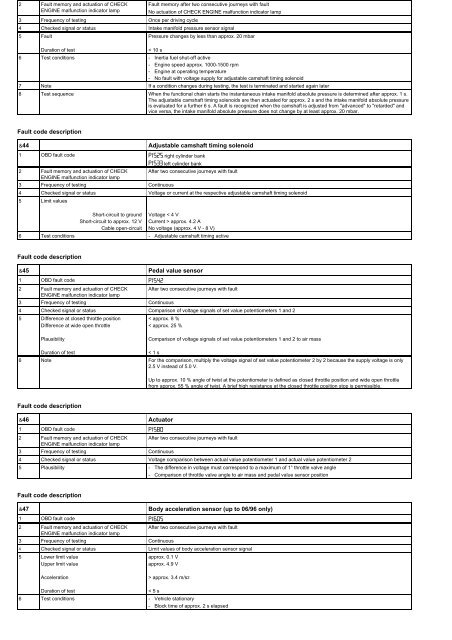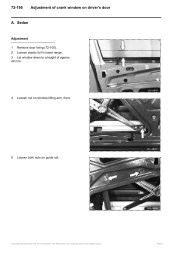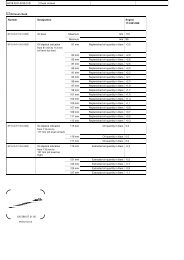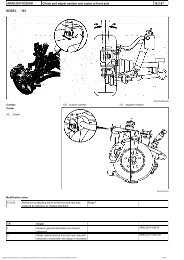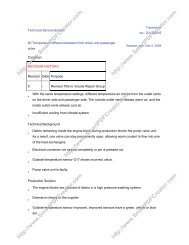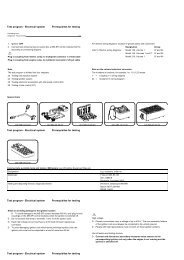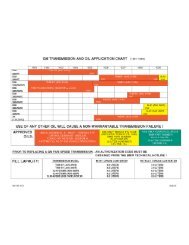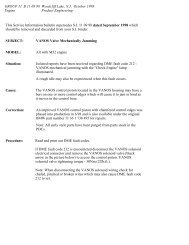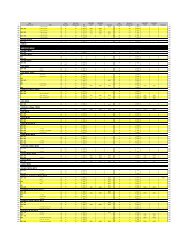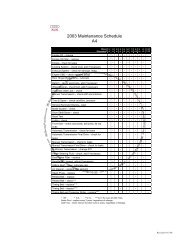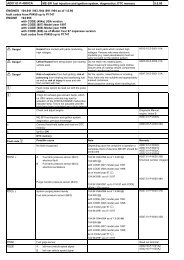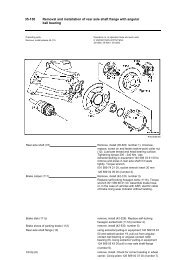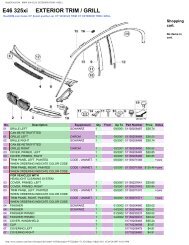W140 Fault Codes_ Description.pdf
W140 Fault Codes_ Description.pdf
W140 Fault Codes_ Description.pdf
Create successful ePaper yourself
Turn your PDF publications into a flip-book with our unique Google optimized e-Paper software.
2 <strong>Fault</strong> memory and actuation of CHECKENGINE malfunction indicator lamp<strong>Fault</strong> memory after two consecutive journeys with faultNo actuation of CHECK ENGINE malfunction indicator lamp3 Frequency of testing Once per driving cycle4 Checked signal or status Intake manifold pressure sensor signal5 <strong>Fault</strong>Pressure changes by less than approx. 20 mbarDuration of test< 10 s6 Test conditions - Inertia fuel shut-off active- Engine speed approx. 1000-1500 rpm- Engine at operating temperature- No fault with voltage supply for adjustable camshaft timing solenoid7 Note If a condition changes during testing, the test is terminated and started again later8 Test sequence When the functional chain starts the instantaneous intake manifold absolute pressure is determined after approx. 1 s.The adjustable camshaft timing solenoids are then actuated for approx. 2 s and the intake manifold absolute pressureis evaluated for a further 6 s. A fault is recognized when the camshaft is adjusted from "advanced" to "retarded" andvice versa, the intake manifold absolute pressure does not change by at least approx. 20 mbar.<strong>Fault</strong> code description&44 Adjustable camshaft timing solenoid1 OBD fault code PI525 right cylinder bankPI533 left cylinder bank2 <strong>Fault</strong> memory and actuation of CHECK After two consecutive journeys with faultENGINE malfunction indicator lamp3 Frequency of testing Continuous4 Checked signal or status Voltage or current at the respective adjustable camshaft timing solenoid5 Limit valuesShort-circuit to groundShort-circuit to approx. 12 VCable open-circuitVoltage < 4 VCurrent > approx. 4.2 ANo voltage (approx. 4 V - 8 V)6 Test conditions - Adjustable camshaft timing active<strong>Fault</strong> code description&45 Pedal value sensor1 OBD fault code PI5422 <strong>Fault</strong> memory and actuation of CHECK After two consecutive journeys with faultENGINE malfunction indicator lamp3 Frequency of testing Continuous4 Checked signal or status Comparison of voltage signals of set value potentiometers 1 and 25 Difference at closed throttle positionDifference at wide open throttle< approx. 8 %< approx. 25 %PlausibilityComparison of voltage signals of set value potentiometers 1 and 2 to air massDuration of test< 1 s6 Note For the comparison, multiply the voltage signal of set value potentiometer 2 by 2 because the supply voltage is only2.5 V instead of 5.0 V.Up to approx. 10 % angle of twist at the potentiometer is defined as closed throttle position and wide open throttlefrom approx. 55 % angle of twist. A brief high resistance at the closed throttle position stop is permissible.<strong>Fault</strong> code description&46 Actuator1 OBD fault code PI5802 <strong>Fault</strong> memory and actuation of CHECK After two consecutive journeys with faultENGINE malfunction indicator lamp3 Frequency of testing Continuous4 Checked signal or status Voltage comparison between actual value potentiometer 1 and actual value potentiometer 25 Plausibility - The difference in voltage must correspond to a maximum of 1° throttle valve angle- Comparison of throttle valve angle to air mass and pedal value sensor position<strong>Fault</strong> code description&47 Body acceleration sensor (up to 06/96 only)1 OBD fault code PI6052 <strong>Fault</strong> memory and actuation of CHECK After two consecutive journeys with faultENGINE malfunction indicator lamp3 Frequency of testing Continuous4 Checked signal or status Limit values of body acceleration sensor signal5 Lower limit valueUpper limit valueapprox. 0.1 Vapprox. 4.9 VAcceleration> approx. 3.4 m/s2Duration of test< 5 s6 Test conditions - Vehicle stationary- Block time of approx. 2 s elapsed


